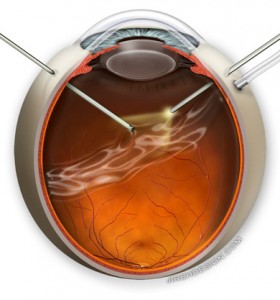 FOV, Floater Only Vitrectomy, should not change your refraction. This means, if you are anticipating either cataract surgery or even LASIK, you should not worry about the vitrectomy causing you to change your refraction.
FOV, Floater Only Vitrectomy, should not change your refraction. This means, if you are anticipating either cataract surgery or even LASIK, you should not worry about the vitrectomy causing you to change your refraction.
On the other hand, if you’ve had PRK, LASIK or cataract surgery, you can still have a FOV.
What is FOV?
FOV, or Floater Only Vitrectomy, is simply a vitrectomy. During a vitrectomy, instruments are introduced into the eye through the pars plana – an area behind the cornea and lens/cataract.
The instruments cut away the vitreous without bothering the lens or cornea.
Using an operating microscope, I am looking into your eye through the cornea and lens. I’m actually operating behind the lens and cornea.
LASIK/Laser Vision Correction
Laser Vision Correction (Lasik, RK, PRK, etc.) procedures all require surgery on the cornea. Essentially, by laser or cutting, the curvature of the cornea is altered to result in a dramatic change in the vision.
The surface and curvature of the cornea are responsible for about 2/3 of the focusing power of the eye. Refractive surgery is successful due to the manipulation of this surface.
Cataract Surgery
Cataract surgery involves removal of the cataract through an incision in the cornea. After the cataract is removed, in implant replaces the cataract which was just removed.
The implant is placed into the eye through the same incision by which the cataract was removed. With modern cataract surgery – there is no change in the curvature of the cornea once healing is complete.
Length of the Eye
The distance, or length, between the surface of the cornea and the surface of the retina has a direct impact on the refraction of the eye. The longer the eye, the more nearsighted. The shorter the eye, the more farsighted.
A scleral buckle is used to repair a retinal detachment. A common side effect of scleral buckles is elongation of the eye, that is, nearsightedness is created when a scleral buckle is used.
Parts of the Eye Which Change Refraction
There are only 3 factors which effect your refraction;
- Corneal Curvature
- Presence of a Cataract
- Length of the Eye
FOV, or vitrectomy for floaters, can be performed after having had laser vision correction, cataract surgery or retinal detachment surgery. The surgery to remove floaters does not involve either the cornea, lens or length or shape of the eye.
If you are contemplating laser vision correction or cataract surgery, don’t worry too much about the timing before or after FOV… it just doesn’t matter.
Randy
Randall V. Wong, M.D.
Ophthalmologist, Retina Specialist
Fairfax, Virginia
RetinaEyeDoctor.com